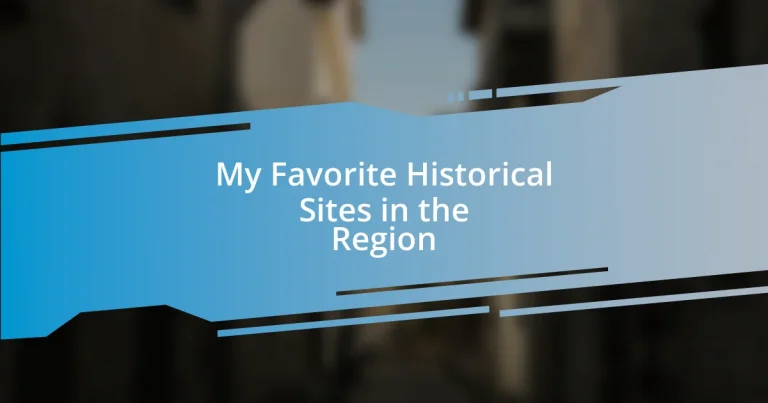Key takeaways:
- Historical sites serve as vital connections to our past, offering cultural education, heritage preservation, and emotional ties to personal identity.
- Notable architectural styles reflect societal evolution and cultural influences, enhancing our understanding of history through visual narratives.
- Visiting historical sites fosters reflection on personal connections to the past, encouraging appreciation of sacrifices and shared human experiences.

My favorite historical sites
One of my absolute favorite historical sites is the old fortress overlooking the river. I remember visiting it as a child, feeling the weight of history with every step on those ancient stones. What is it about those weathered walls that sparks a sense of adventure and curiosity in us?
Another site that holds a special place in my heart is the colonial town nearby. Wandering through its cobblestone streets, I often found myself imagining what daily life must have been like centuries ago. It makes me wonder: how have those who walked there navigated the same challenges we face today?
Then, there’s the iconic battlefield that tells tales of bravery and sacrifice. Standing on that hallowed ground, I can’t help but feel a deep connection to those who fought for their beliefs. Have you ever stood somewhere that made you reflect deeply on the cost of freedom? It’s a powerful reminder that history is not just about dates and events, but the lives that shaped our world.

Importance of historical sites
Historical sites serve as crucial links to our past, allowing us to connect with the stories and experiences of those who came before us. I recall one visit to an ancient temple where the intricate carvings seemed to whisper secrets of rituals and beliefs long forgotten. It was a humbling experience that deepened my appreciation for the diverse cultures that shaped our world.
Here are a few reasons why historical sites are so important:
- Cultural Education: They provide invaluable insights into different cultures and lifestyles.
- Preservation of Heritage: These sites help preserve the heritage and identity of communities.
- Inspiration for Future Generations: Visiting these places can inspire a sense of responsibility to protect our history.
- Tourism and Economy: They attract tourists, boosting local economies and creating jobs.
- Emotional Connections: They allow individuals to forge emotional ties to their ancestry and history, adding depth to personal identity.
Through my experiences exploring these sites, I find that each visit is more than just a trip; it’s an invitation to reflect on what has shaped us and how we can carry those lessons forward. It’s a unique blend of nostalgia and reverence that leaves a lasting imprint on the heart.

Notable architectural styles
Notable architectural styles reflect the evolution of societies, serving as a visual narrative of cultural influences and historical contexts. Each style carries its own story, resonating with emotions that speak to all who stand before them. For instance, during one of my travels, I marveled at the Gothic cathedrals with their soaring spires and intricate stained glass. There’s a certain mystique in those dark, lofty spaces that sends shivers down my spine, invoking a sense of wonder and contemplation.
When I stood before a classic Victorian house, I couldn’t help but admire its ornate details and vibrant colors. The sense of craftsmanship was palpable, each embellishment telling tales of the past and the lives lived within those walls. It sparks an interesting thought: How much of our current architectural choices will stand the test of time in the same way? I find myself pondering how architectural styles are not merely structures, but reflections of the values, aspirations, and challenges of their time.
To better illustrate the various architectural styles found in the region, here’s a comparison table that highlights some notable examples:
| Architectural Style | Key Characteristics |
|---|---|
| Gothic | Pointed arches, flying buttresses, intricate stained glass |
| Victorian | Ornate details, asymmetrical shapes, vibrant colors |
| Colonial | Simplicity, symmetry, function-based design |
| Modern | Minimalist, open spaces, use of new materials |

Personal experiences and anecdotes
There’s a particular day that stands out vividly in my memory—a visit to an ancient ruin that seemed to breathe history. As I wandered through the stone pathways, I felt like a time traveler, surrounded by whispers of the past. It made me wonder, have we truly lost touch with that sense of wonder, or does it just take the right setting to unlock those feelings within us?
Another unforgettable moment occurred when I participated in a reenactment at a historical battlefield. Wearing the period clothing and engaging in the drills, I experienced a fraction of what those soldiers must have felt. The camaraderie and tension were palpable, making me reflect on the sacrifices made for our freedom. It’s incredible how such experiences can transform abstract historical events into personal stories that resonate so deeply.
I’ll never forget the tranquility of standing in the shadow of a centuries-old castle. The fortress walls seemed to carry the weight of countless stories, and in that silence, I could almost hear the laughter and cries of past lives. Isn’t it fascinating to think that each stone holds memories, binding us to those who walked the same grounds? It’s these moments of connection that truly highlight why I cherish historical sites; they remind us that our lives are woven into the broader narrative of humanity.

Tips for visiting historical sites
When visiting historical sites, I’ve found that timing can make a world of difference. Early mornings or late afternoons often bring fewer crowds, allowing for a more intimate experience with the surroundings. I remember strolling through an ancient monastery just as the sun began to set, casting a golden hue on the stones. That serene moment felt sacred, almost like I was witnessing history unfold.
I also recommend immersing yourself in the stories behind the sites. Before my visit to a famous battlefield, I took some time to read about the events that transpired there. This preparation shifted my perspective dramatically. Instead of just walking through a location, I felt a deep connection, as if I was stepping into a pivotal scene of the past. It’s interesting how history can become more vivid when you engage with it on a deeper level—don’t you think?
Lastly, I always suggest participating in guided tours or local talks when available. The insights from knowledgeable guides can add layers of context that you might overlook on your own. I once joined a walking tour led by a passionate historian who shared anecdotes and lesser-known facts that enriched my understanding of a historic district. Have you ever noticed how a great storyteller can breathe life into the past? It truly transforms the experience, making it unforgettable.

Connecting with local history
There’s something wonderfully grounding about standing on the very soil where history unfolded. I recall visiting a local heritage site dedicated to the early settlers in my region. As I explored the replica cabins, the scent of wood and earth reminded me of stories my grandparents used to tell. Have you ever felt that connection, where stories from your childhood suddenly feel alive? It’s breathtaking how places can evoke memories and emotions, bridging the past with our present.
Sometimes, it’s the small details that leave the biggest impression on us. I was once captivated by a modest plaque at an unassuming location. It commemorated a community event from decades ago that I had never learned about. Reading it felt personal, as if I was peering into the lives of people who had faced similar struggles and triumphs. Isn’t it amazing how a few words can instantly connect us to those who came before us, offering a glimpse into their aspirations and dreams?
Every historical site I visit offers a unique opportunity to reflect on my own life in relation to the past. I remember a moment at a local museum where an exhibit showcased personal letters from soldiers in a significant war. As I read their heartfelt messages, I felt an intense mix of sorrow and gratitude. Those words brought their struggles to life, reminding me of the sacrifices made for the freedoms we enjoy today. How do we honor those sacrifices in our daily lives? This connection to history always inspires me to appreciate the present and encourage others to explore our shared human experience.













